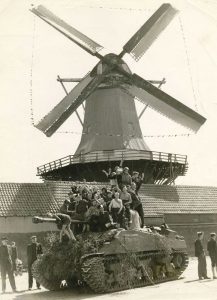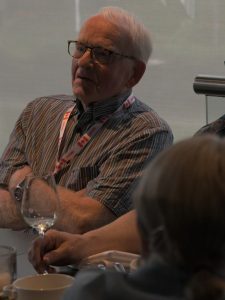
In the last spring of the Second World War, Dutch citizens sensed that five years of Nazi occupation might soon be over. On May 4, 1945, the Allies would force German armies to surrender and restore freedom to millions of Dutch people.
At the time, five-year-old Harry Beukeboom, along with 18 siblings, lived on a farm outside Amsterdam. During that last “hunger winter” of 1945, his parents hid enough food from the Germans to keep the family alive.
“One morning, my dad and oldest brother were out milking cows,” explained Beukeboom on a recent Liberation tour to the Netherlands. “All of a sudden, a bomb hit the ground about 200 metres from them. Shrapnel missed him … but killed a cow in a neighbour’s barn.”
Young Harry couldn’t understand why an Allied bomber “tried to kill us. … Years later, I learned from air force veterans that the bomber likely released its bomb over countryside because the crew and plane were in peril.”

For the past week, I’ve led 47 fellow Canadians – including Harry Beukeboom and his wife Louise (also Dutch-born) – on a tour over land that Canadian troops liberated 80 years ago this month. About 7,600 Canadian servicemen and women paid with their lives.
And though I’ve written and spoken for 50 years about this selfless sacrifice by Canadians and precious gift to the Dutch, over the past week I’ve also gained insight to the unseen cost. Freedom is not free.
One day during our trip, Albertan Leo Bruseker, 74, described how his father resorted to disappearing during German occupation of the Netherlands. At the time, Theo Bruseker was studying at the University of Amsterdam.

Eventually, the Nazis insisted that all Dutch citizens sign pledges of allegiance to Hitler and the Nazis. Theo Bruseker said no, and over the next five years became an onderduiker (meaning “to dive under”) dodging the German dragnet that sent most able young Dutch men to Germany to work in Nazi munitions plants.
For a time, Bruseker hid in a groundskeeper’s cottage near Utrecht, but ultimately returned to Amsterdam “and never left the house. If you were out after dark, after curfew, German soldiers didn’t hesitate; they shot you dead.”

Members of the Dutch resistance chose to run that risk. Among them was a former Dutch soldier named Jacob van Abbema from the Friesland area of northern Netherlands. His daughter, Hilda Smeltzer, who joined us for this tour, explained when the Germans invaded the Netherlands in 1940, her parents had three choices:
Do nothing and hope for the best. Go into hiding. Or join the resistance. Her parents chose to resist.
“My brother said when Dad occasionally came home, he used his gun as a door jam and placed the bullets on the kitchen counter,” she said.
“My brother remembered the razzia, when German troops (cordoned off streets or entire villages) confiscating radios, food and young men for slave labour (in Germany). … Mom hid a radio in her washing. Dad hid in the cold cellar.”

Later during our trip, John van Troost described his family’s similar wartime experience during German occupation. “They took (my father and uncle) to a factory where they made Stuka dive bombers,” he said.
“They were working on an assembly line, watched very closely for sabotage, and if they suspected you were doing something to disrupt the (Nazi) war effort, they shot you right there on the line,” he said.
Three times the van Troost brothers bribed guards in an attempt to escape, but didn’t follow through; the fourth time, near the German-Swiss border they made a break for it, swimming across a narrow river; they were assisted by resistance fighters who fired back at German guards.
“When my uncle Piet came to visit us in Hamilton,” John van Troost added, “we took him to the Canadian Warplane Heritage Museum. At that time the CWHM had a Corsair (a WWII navy fighter aircraft); when my uncle spotted it, he walked up to it and hugged the propeller … because it was the same shape as the propeller of the Stuka dive bombers he’d been forced to work on in Germany.
Last Tuesday, our tour stopped at Wageningen, in central Netherlands, where we visited a modest hotel just off the city’s central square. Inside a sitting room at the Hotel de Wereld, on May 5, 1945, Canadian Gen. Charles Foulkes received the surrender of German armies that had occupied Harry Beukeboom’s country of birth. Setting foot inside this room where the Germans capitulated meant a lot to Beukeboom.
“Our freedom began here,” he said.